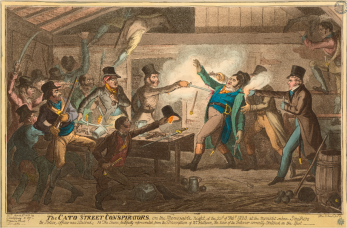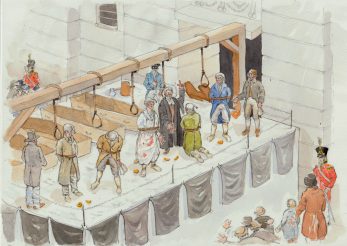The Cato Street Conspiracy: A Real Life Drama set in Grosvenor Square Part Five



Does Bridgerton do justice to the period of the Cato Street Conspiracy?
2021 has seen Bridgerton, a period drama set in Grosvenor Square, become the biggest tv phenomenon of lockdown. This article brings to a conclusion our comparison of the Netflix series, Bridgerton, with the Cato Street Conspiracy.
There is no doubt that Bridgerton makes brilliant tv. Sixty two million people cannot be wrong. Shonda Rimes didn’t seek to recreate an historical Regency, but I still feel it’s a shame that the series doesn’t reflect the precarious situation the Ton existed in during the Regency. The Cato Street Conspiracy is evidence that Britain very nearly saw a bloody revolution to match that of our Gallic cousins across the Channel. Netflix presents a fantasy London, which works brilliantly as escapism in our grim Covid laden times. However, for me the series misses an opportunity to make people aware of a group that included, with William Davison and Robert Wedderburn, real Black Londoners, whose lives were equally as dramatic as those cast in this fictionalised show. By including a boxer based on Bill Richmon they proved that adding an historical character could add depth to a fictionalised story. If only we had a cabinet maker rather than a boxer with a part based on William Davidson. This would have allowed Bridgerton to portray the potent class differences that existed in early nineteenth century London. Moreover, it would have allowed them to explore interesting perspectives and conflicts, which might have taken the programme to a different level. Sadly, we are never taken into the parallel world that existed beneath the glamour they place on screen. Netflix omitted any reflection on the lives of those who existed at the bottom of the Regency world, for whom life was one of grinding poverty and hardship. There were no elegant housing developments for the lower part of society in this London; they lived like Robert Wedderburn in violent “rookeries”, such as at St Giles, where even the law feared to tread. The programme celebrates diversity in its casting but does not explore the precarious place in society that its central character the Duke of Hasting inhabits because of his colour. The Duke’s best friend, a boxer, is essentially just a device — at times a literal sparring partner that fails to land a blow. If only the Duke had a best friend named William.
Having spent some time researching the story of the Cato Street Conspirators, I wish their story could reach an audience of the size that Bridgerton has. I believe they deserved it. The Cato Street Conspirators matched the Gunpowder plotters in their daring—and in their fate—but sadly their story is almost unknown. There is no annual commemoration like Guy Fawkes night to keep alive the names of the Cato Street conspirators—Arthur Thistlewood, William Davidson, James Ings, Richard Tidd and John Brunt. Perhaps I’ll have to pass our films of William Davidson onto Shonda Rimes!





No Comments
Add a comment about this page